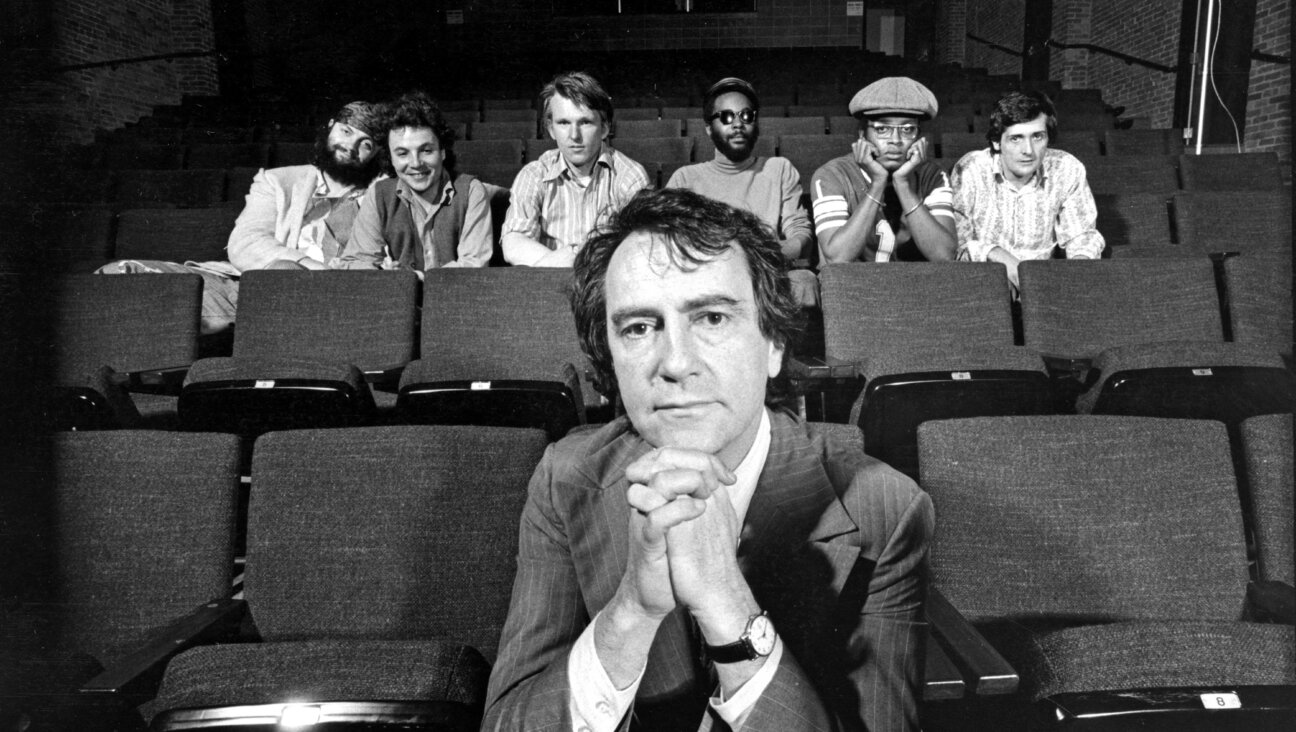A deep-dive into the issue of gender in Yiddish literature

Image by legenda
Read this article in Yiddish.
Women, Men and Books: Issues of Gender in Yiddish Discourse
Gennady Estraikh, Mikhail Krutikov (Editors)
Legenda, $99, 206 PP
“Historically, the gender division in Yiddish was arguably the strongest among European languages.”
So begins co-editor Mikhail Krutikov’s introduction to the new book, Women, Men and Books – “Issues of Gender in Yiddish Discourse.” A collection of various studies, the book presents the most recent research on the subject of gender in Yiddish literature and culture and paints a far more complex picture of gender roles in Eastern European Jewish life than is portrayed in traditional sources.
In the first chapter, Arnaud Bikard, an expert in Old Yiddish literature, discusses a 16th century epic poem that appears in a long manuscript entitled Seder Noshim – the order, or customs, of women – an example of the moralizing, didactic texts written for women during that period. The invention of the printing press in the mid-15th century led to the publication of many Yiddish books on Jewish religion and morals, and even prayer books. The reason they were in Yiddish was because they were targeting women readers and women simply didn’t know loshn-koydesh, the Hebrew-Aramaic holy tongue.
Until now, that epic poem that was nestled inside the didactic text was considered an integral part of it. Bikard argues, though, that while the first section of Seder Noshim is indeed a traditional guide to female piety, the second part, which includes this poem, is an entirely separate piece of work. In fact, he writes, it’s a work of satire. By analyzing the poem as a distinct piece, Bikard explains that it really doesn’t fit within the canon of traditional Yiddish literature for women, but is actually more closely related to the querelle des femmes debates prominent in European literature at the time. Usually translated as “the women question,” these debates discussed the nature and treatment of women, their capabilities and their role in society at a time of social change.
Bikard’s work shows that at the same time that books were being published as guides for women on how to live a pious Jewish life, traditional gender roles were also being questioned in Jewish intellectual circles. It also reminds us that even while Ashkenazi Jews were restricted to ghettos, they were not as culturally isolated as we might assume.
By highlighting the poem’s satirical, playful and sometimes even vulgar and misogynistic character, Bikard demonstrates that, even in the 16th century, Jewish women were not represented solely as pious daughters, wives and mothers. The poem both praises women as the givers of life, and at the same time pokes fun at them, sometimes even describing them as sinful temptresses who might lead men astray.
As other studies in this volume show, these contradictions also appeared in modern Yiddish literature of the late 19th and early 20th centuries. In another chapter of the book, Roni Masel describes how the legend of the Polish King Casimir and his Jewish lover, Esterke, were depicted in both Yiddish and Hebrew literature and how the character of Esterke often portrayed Jewish women as national saviors on the one hand and agents of assimilation on the other.
The theme of women as mediums of assimilation and modern change is one that seems to appear frequently, at least in the early decades of modern Yiddish literature. Gennady Estraikh, who co-edited the volume with Krutikov, argues that much of the work of the first generation of modern Yiddish writers, including that of the celebrated Sholem Aleichem, was characterized by an attachment to traditional male and female gender roles. In his study of the famous shund (pulp fiction) novelist, Shomer, Estraikh reveals how the popular writer regarded modern, emancipated women with fear.
This theme is repeated in other chapters of Women, Men and Books, as in Valentina Fedchenko’s study of two stories by Isaac Bashevis-Singer, and Eitan Kensky’s discussion of virility in the poetry of the first Yiddish literary movement in America, Di Yunge (the Young Ones). Poets Mani Leib and Dovid Ignatov, both members of the group, often portrayed American women as erotic characters, seducing Jewish men with the temptations of modernity and assimilation and thereby threatening traditional Jewish life.
Kensky underlines how, while modern women were seen as temptresses, particularly in an immigrant context, the image of the modern man was associated with a loss of Jewish identity. As Estraikh and Fedshenko’s chapters also demonstrate, the attitude of male writers toward women was inevitably linked to their understanding of their own masculine identities at a time when gender roles were changing. This new book distinguishes itself from previous such studies in that many of the collected articles are concerned not primarily with women and femininity, but with men and masculinity – a crucial topic since, as Krutikov points out, Yiddish literature has long been dominated by male voices, despite its reputation as a vayberish or feminine language compared to the more masculine tongue, Hebrew.
This dichotomy is also discussed in the chapter by Yaakov Herskovitz, who compares the Hebrew and Yiddish works of the Hebrew writer Aharon Reuveni, where he discusses the commonly held notion that while the writers of Hebrew and especially Zionist literature tended to embrace new, modern ideals of masculinity, male Yiddish authors and publishers often viewed such ideals with hesitation.
However, the question of masculinity in Yiddish literature, like that of femininity, is not a simple one. As Sabine Koller shows in her study of the early erotic poetry of Soviet-Yiddish poet David Hofstein – in which both masculinity and femininity were freed from their traditional restrictive stereotypes – some writers used Yiddish to actually create more modern masculine characters.
Another example brought up in the book is the early 20th century journalist Jacob Botoshansky, who immigrated from Romania to Argentina and wrote about his experiences there. The author of this chapter, William Runyan, suggests that, through Botoshansky’s own self-representation as an explorer, discovering new places and describing them from a distinctly Yiddish perspective, his style can be seen as an attempt to remake the Jewish man in line with the modern masculine ideal. His reportage also demonstrates how colonial fantasies were played out in Yiddish discourse, which Runyan contrasts with the huge power imbalances between Jewish men and women in the colonial – in this case, South American – reality.
While many of the studies here deal with the work of men, others center on the voices of female writers who have been neglected by the Yiddish canon. Joanna Lisek, looking at the experiences of mothers and daughters as portrayed by female Yiddish poets, reveals the variety and creativity with which Jewish women reacted to the modern world.
Zohar Weiman-Kelman, meanwhile, criticizes the way in which the work of women has been viewed as a distinct category of Yiddish literature, overlooking its significance for Yiddish and Jewish literature as a whole. Comparing the work of female Yiddish poets with that of lesbian writers, Weiman-Kelman demonstrates how these communities have challenged their marginalization, and how we might continue this work to restore female and queer voices to their rightful place in Yiddish culture – work she has continued in her 2019 book. “Queer Expectations: a geneology of Jewish Women’s poetry”. Weiman-Kelman’s work, alongside many of the other studies collected here, reveals that conceptions of gender in Yiddish culture were not always as binary and traditional as we tend to assume.
Roland Grushka, whose chapter deals with the relatively unknown work of three socialist and anarchist activist-writers, discusses the Marxist theory of gender as a class-construction as propagated by Yiddish theorists. Radical socialist and former associate-editor of the Forverts Benjamin Feigenbaum, for example, used his translations of famous socialist works to elaborate upon the Marxist idea of a primitive ‘matriarchy’, using examples taken from the Hebrew Bible. In his translations of Marxist works, Feigenbaum expanded on the argument that the domination of men over women was not natural, but a historical development, and the first example of the subjugation of one group of people over another, which would eventually result in the deeply divided, unequal modern society he and others were struggling to transform. Gruskha also discusses Feigenbaum’s development of a theory of gender as constructed by language, which, although he did not extend it this far, has since become central to the growing field of Gender Studies.
In the last and arguably one of the most important chapters of the book, titled The “Bathroom Crisis” in the Shtetl, Alexandra Tali Herzog describes how I. B. Singer used Talmudic concepts of gender to create characters who did not conform to either male or female gender binaries. Although, as Valentina Fedshenko’s chapter demonstrates, Bashevis himself seems to have regarded such ambiguity with anxiety and even derision, his work nonetheless reveals, in Herzog’s words “an Eastern Eastern European tradition that was far more open to permutations of gender and sexuality than is commonly understood.” Tali Herzog argues that, in contrast to current public discourse, it was fluidity in sexuality and not gender that Bashevis found more difficult to accept.
Interestingly, in comparing the Yiddish originals of two of Bashevis’ novels alongside their English translations, Fedshenko reveals that Jewish life is portrayed as far more traditional in the English versions, written for an American audience, while the characters in the Yiddish originals are more ‘ambiguous’ in terms of gender presentation and sexuality. The traditional, fixed gender roles we tend to associate with Eastern European Jewry may therefore have more to do with the way portrayals of Ashkenazi life have been adapted to fit into conventional anglophone stereotypes than with reality.
As gender and sexuality are increasingly being understood as fluid, rather than determined categories, this kind of research is extremely significant for those of us who still speak, write and create in Yiddish, and want to hold on to it as a living language, capable of expressing all of our experiences. Queer, gay and trans people have not just suddenly appeared in society; they have always been there, even in the traditional world of Ashkenazi Jewry. As with the ignored voices of women, we simply have to learn how to look for them.























